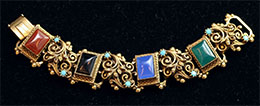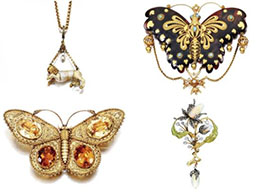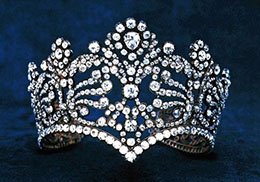A History of Jewelry
Jeweler is a universal form of adornment. Jeweler made from shells, stone and bones survives from prehistoric times. It is likely that from an early date it was worn as a protection from the dangers of life or as a mark of status or rank.
In the ancient world the discovery of how to work metals was an important stage in the development of the art of jeweler. Over time, metalworking techniques became more sophisticated and decoration more intricate.
Gold, a rare and highly valued material, was buried with the dead so as to accompany its owner into the afterlife. Much archaeological jeweler comes from tombs and hoards. Sometimes, as with the gold collars from Celtic Ireland which have been found folded in half, it appears people may have followed a ritual for the disposal of jeweler.
Medieval jeweler 1200–1500
The jeweler worn in medieval Europe reflected an intensely hierarchical and status-conscious society. Royalty and the nobility wore gold, silver and precious gems. Humbler ranks wore base metals, such as copper or pewter. Color (provided by precious gems and enamel) and protective power were highly valued.
Until the late 14th century, gems were usually polished rather than cut. Size and lustrous color determined their value. Enamels - ground glasses fired at high temperature onto a metal surface - allowed goldsmiths to color their designs on jeweler. They used a range of techniques to create effects never since surpassed.
Some jewels have cryptic or magical inscriptions, believed to protect the wearer.

Renaissance jeweler
Renaissance jewels shared the age's passion for splendour. Enamels, often covering both sides of the jewel, became more elaborate and colorful. Advances in cutting techniques increased the glitter of stones.
The enormous importance of religion in everyday life could be seen in jeweler, as could earthly power - many spectacular pieces were worn as a display of political strength.
The designs reflect the new-found interest in the classical world, with mythological figures and scenes becoming popular. The ancient art of gem engraving was revived. The inclusion of portraits reflected another cultural trend - an increased artistic awareness of the individual.

17th-century jeweler
By the mid-17th century, changes in fashion had introduced new styles of jeweler. While dark fabrics required elaborate gold jeweler, the new softer pastel shades became graceful backdrops for gemstones and pearls. Expanding global trade made gemstones ever more available. Advances in cutting techniques increased the sparkle of gemstones in candlelight.
The most impressive jewels were often large bodice or breast ornaments, which had to be pinned or stitched to stiff dress fabrics. The swirling foliate decoration of the jewels shows new enthusiasm for bow motifs and botanical ornaments.

18th-century jeweler
The end of the previous century had seen the development of the brilliant-cut with its multiple facets. Diamonds sparkled as never before and came to dominate jeweler design. Frequently mounted in silver to enhance the stone's white color, magnificent sets of diamond jewels were essential for court life. The largest were worn on the bodice, while smaller ornaments could be scattered over an outfit.
Owing to its high intrinsic value, little diamond jeweler from this period survives. Owners often sold it or re-set the gems into more fashionable designs.

Comment (0)